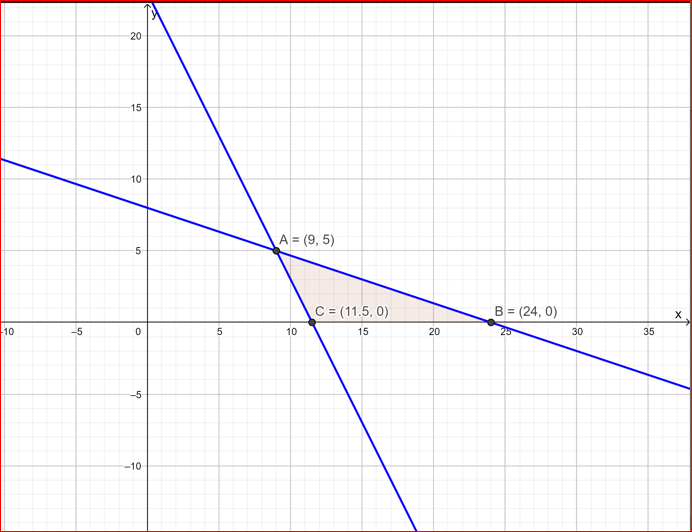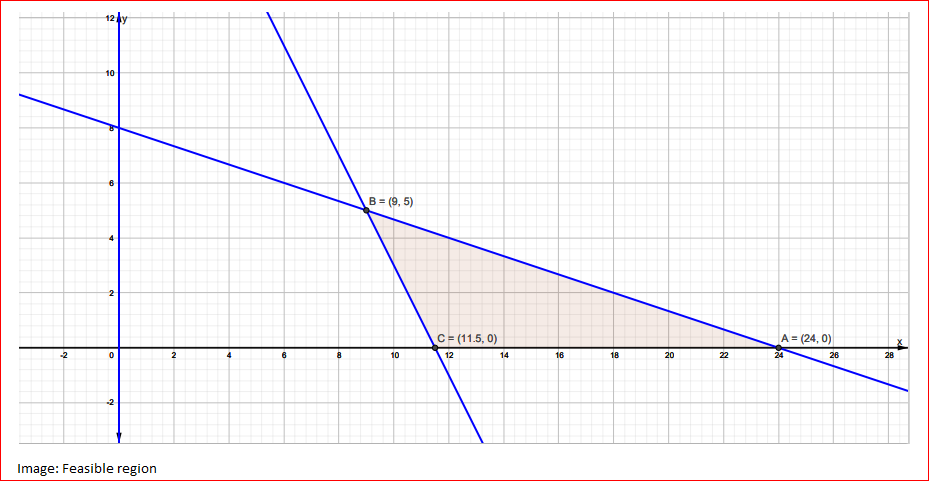
What is the maximum value of \[Z\] where, \[Z = 4x + 2y\] subject to constraints \[4x + 2y \ge 46\], \[x + 3y \le 24\] and \[x,y \ge 0\]?
A. 46
B. 96
C. 52
D. None of these
Answer
216k+ views
Hint: First we will solve the inequalities in as an equation. Then draw a diagram using the inequalities. The common region of inequality is known as the feasible region. Then we will find the corner points of the feasible region and substitutes the point in \[Z = 4x + 2y\]. The maximum value of \[Z\] is the required solution.
Formula used:
The intercepts form of a line is \[\dfrac{x}{a} + \dfrac{y}{b} = 1\].
Complete step by step solution
Given that,
\[Z = 4x + 2y\]
subject to constraints
\[4x + 2y \ge 46\]
\[x + 3y \le 24\]
\[x,y \ge 0\]
Now rewrite the inequalities as an equation
\[4x + 2y = 46\] ….(i)
\[x + 3y = 24\] ……(ii)
Rewrite the equation intercepts form
For equation (i)
\[\dfrac{{4x}}{{46}} + \dfrac{{2y}}{{46}} = 1\]
\[ \Rightarrow \dfrac{x}{{11.5}} + \dfrac{y}{{23}} = 1\]
The x-intercept is 11.5 and y-intercept is 23.
For equation (ii)
\[\dfrac{x}{{24}} + \dfrac{{3y}}{{24}} = 1\]
\[ \Rightarrow \dfrac{x}{{24}} + \dfrac{y}{8} = 1\]
The x-intercept is 24 and y-intercept is 8.
Now finding the intersection point equation (i) and (ii)
Multiply 4 with equation (ii) and subtract it from equation (i)
\[4x + 2y = 46\]
\[4x + 12y = 96\]
\[\overline {\,\,\,\, - 10y = - 50} \]
\[ \Rightarrow y = 5\]
Putting \[y = 5\] in the equation (ii)
\[x + 3 \cdot 5 = 24\]
\[ \Rightarrow x = 9\]
The intersection point is \[\left( {9,5} \right)\].
Putting \[\left( {0,0} \right)\] in \[4x + 2y \ge 46\].
\[0 + 0 \ge 46\] which incorrect.
So the region of the \[4x + 2y \ge 46\] is side in which \[\left( {0,0} \right)\] does not lie.
Putting \[\left( {0,0} \right)\] in \[x + 3y \le 24\].
\[0 + 0 \le 24\] which correct.
So the region of the \[x + 3y \le 24\] is side in which \[\left( {0,0} \right)\] lies.
Given that x>0 and y > 0.
So the feasible region must lie in the first quadrant.
Now we will draw a diagram of inequality.

Image: Feasible region

Hence the corner points of the feasible region are \[\left( {9,5} \right)\], \[\left( {24,0} \right)\] and \[\left( {11.5,0} \right)\]
Now putting \[x = 9\] and \[y = 5\] in the equation \[Z = 4x + 2y\]
\[Z = 4 \cdot 9 + 2 \cdot 5\]
\[ = 46\]
Now putting \[x = 24\] and \[y = 0\] in the equation \[Z = 4x + 2y\]
\[Z = 4 \cdot 24 + 2 \cdot 0\]
\[ = 96\]
Now putting \[x = 11.5\] and \[y = 5\] in the equation \[Z = 4x + 2y\]
\[Z = 4 \cdot 11.5 + 2 \cdot 5\]
\[ = 46\]
Thus, the maximum value of 96.
Hence option B is the correct option.
Note: Many students often do a common mistake to calculate the maximum value of \[Z\]. They put intersection point in the equation \[Z = 4x + 2y\] to calculate the maxima value. This is incorrect way. We have to put all corner points in \[Z = 4x + 2y\] to find maximum value of \[Z\].
Formula used:
The intercepts form of a line is \[\dfrac{x}{a} + \dfrac{y}{b} = 1\].
Complete step by step solution
Given that,
\[Z = 4x + 2y\]
subject to constraints
\[4x + 2y \ge 46\]
\[x + 3y \le 24\]
\[x,y \ge 0\]
Now rewrite the inequalities as an equation
\[4x + 2y = 46\] ….(i)
\[x + 3y = 24\] ……(ii)
Rewrite the equation intercepts form
For equation (i)
\[\dfrac{{4x}}{{46}} + \dfrac{{2y}}{{46}} = 1\]
\[ \Rightarrow \dfrac{x}{{11.5}} + \dfrac{y}{{23}} = 1\]
The x-intercept is 11.5 and y-intercept is 23.
For equation (ii)
\[\dfrac{x}{{24}} + \dfrac{{3y}}{{24}} = 1\]
\[ \Rightarrow \dfrac{x}{{24}} + \dfrac{y}{8} = 1\]
The x-intercept is 24 and y-intercept is 8.
Now finding the intersection point equation (i) and (ii)
Multiply 4 with equation (ii) and subtract it from equation (i)
\[4x + 2y = 46\]
\[4x + 12y = 96\]
\[\overline {\,\,\,\, - 10y = - 50} \]
\[ \Rightarrow y = 5\]
Putting \[y = 5\] in the equation (ii)
\[x + 3 \cdot 5 = 24\]
\[ \Rightarrow x = 9\]
The intersection point is \[\left( {9,5} \right)\].
Putting \[\left( {0,0} \right)\] in \[4x + 2y \ge 46\].
\[0 + 0 \ge 46\] which incorrect.
So the region of the \[4x + 2y \ge 46\] is side in which \[\left( {0,0} \right)\] does not lie.
Putting \[\left( {0,0} \right)\] in \[x + 3y \le 24\].
\[0 + 0 \le 24\] which correct.
So the region of the \[x + 3y \le 24\] is side in which \[\left( {0,0} \right)\] lies.
Given that x>0 and y > 0.
So the feasible region must lie in the first quadrant.
Now we will draw a diagram of inequality.

Image: Feasible region

Hence the corner points of the feasible region are \[\left( {9,5} \right)\], \[\left( {24,0} \right)\] and \[\left( {11.5,0} \right)\]
Now putting \[x = 9\] and \[y = 5\] in the equation \[Z = 4x + 2y\]
\[Z = 4 \cdot 9 + 2 \cdot 5\]
\[ = 46\]
Now putting \[x = 24\] and \[y = 0\] in the equation \[Z = 4x + 2y\]
\[Z = 4 \cdot 24 + 2 \cdot 0\]
\[ = 96\]
Now putting \[x = 11.5\] and \[y = 5\] in the equation \[Z = 4x + 2y\]
\[Z = 4 \cdot 11.5 + 2 \cdot 5\]
\[ = 46\]
Thus, the maximum value of 96.
Hence option B is the correct option.
Note: Many students often do a common mistake to calculate the maximum value of \[Z\]. They put intersection point in the equation \[Z = 4x + 2y\] to calculate the maxima value. This is incorrect way. We have to put all corner points in \[Z = 4x + 2y\] to find maximum value of \[Z\].
Recently Updated Pages
JEE Atomic Structure and Chemical Bonding important Concepts and Tips

JEE Amino Acids and Peptides Important Concepts and Tips for Exam Preparation

Electricity and Magnetism Explained: Key Concepts & Applications

Chemical Properties of Hydrogen - Important Concepts for JEE Exam Preparation

JEE Energetics Important Concepts and Tips for Exam Preparation

JEE Isolation, Preparation and Properties of Non-metals Important Concepts and Tips for Exam Preparation

Trending doubts
JEE Main 2026: Application Form Open, Exam Dates, Syllabus, Eligibility & Question Papers

Derivation of Equation of Trajectory Explained for Students

Hybridisation in Chemistry – Concept, Types & Applications

Understanding the Angle of Deviation in a Prism

Understanding Collisions: Types and Examples for Students

How to Convert a Galvanometer into an Ammeter or Voltmeter

Other Pages
JEE Advanced Marks vs Ranks 2025: Understanding Category-wise Qualifying Marks and Previous Year Cut-offs

Ideal and Non-Ideal Solutions Explained for Class 12 Chemistry

Degree of Dissociation: Meaning, Formula, Calculation & Uses

Understanding Electromagnetic Waves and Their Importance

Understanding the Electric Field of a Uniformly Charged Ring

Understanding Average and RMS Value in Electrical Circuits




